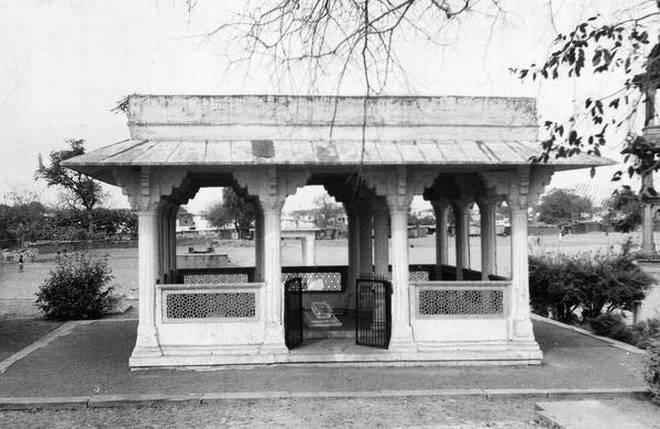Gwalior, MADHYA PRADESH :

He created many ragas, could produce any sound and lent a distinct style to Senia gharana
This gharana is made up of the legend of Tansen, the father of Indian classical music. Though Tansen was a vocalist, the gharana also produced sitar maestros. The Senia style of sitar playing started with the legendary Ustad Maseet Sen, who belonged to the sixth generation in the Tansen lineage. ( The pioneer of Maseetkhani style, even today, 100 years later, the Maseetkhan Baj is played by the sitarists of this gharana. These musicians came to be known as the sitarists of Jaipur Senia Gharana. They lay emphasis on the purity of raga and technique. Their style of playing was that of the bin or veena. Ustad Mushtaq Ali Khan, son of Ashiq Ali Khan of Varanasi had the privilege of learning from Ustad Barkhat Ali khan of Jaipur, who went by the title ‘Aftab-e-Sitar’. Pt. Debu Choudhuri was fortunate to learn from ‘Dada Guru’ (Ustad Mushtaq Ali Khan).
On the vocal front, the gharana is referred to as Qawwal Bachcha. Its most well-known exponent of our time is the Lucknow-based Ustad Shamshudeen Khan, popularly called Ustad Gulshan Bharathi (recepient of ‘Yash Bharathi’ award). This style is known as bol bant ki gayaki and bol banav ki gayaki. Short and crisp bol taans are significant features, while the aakar is sparingly used. Many of his disciples have made a mark in films, notable among them being Shashi Suman, music composer of Bajirao Mastani and Harjeet Saxena.
Coming back to Mian Tansen. He was born as Ramatanu and later came to be known as Tanna. There are many legends woven around his life. It is said that he could produce any sound. The story goes that once when the sadhus were crossing a field they heard a lion’s roar and located it to a young boy sitting on a tree. They advised his father to send him to Swami Haridas for training.
However, it is believed that Tansen was born dumb and was taken to the Sufi saint Murshid Mohammed Ghouse Gwaliari. On reaching Gwalior, he visited the Sufi saint and found him in the company of Swami Haridas. The saint blew air into the mouth of the child and Tanna began to speak. When the saint came to know the child was also deaf, he blew air into his ears and he was cured. The Sufi saint then asked Swami Haridas to take him into his fold. Thus began his musical journey (M.A Bakhy).
Titles to Tansen
Tansen was the title given to him by Raja Vikramjit of Gwalior. Tansen was a court musician in the darbar of Raja Ramachandra of Bandavagarh (Rewa).
When Akbar heard of his prodigious talent, he sent a ‘firman’ to the king asking for Tansen and made him one of the Navaratnas in his court. He gave him the title of ‘Mian’. Tansen is also known as the ‘Sangit Samrat’, according to Musical Heritage of India by Lalita Ramakrishna.
Abul Fazl records in his Ain-i-Akbari that Akbar gave Rs 2 lakhs to Tansen for his first performance in the court. He composed many dhrupads on Ganesha, Shiva, Parvati and Rama. He also composed songs on his patrons.
Kalpadruma is a compliation of 300 of his dhrupads that were in Gauhar Bani. Tansen composed in his favourite ragas — Multani, Bhairavi and Todi .
He invented the night raga Darbari Kanhra, morning raga Mian Ki Todi, mid-day raga, Mian ki Sarang, seasonal raga Mian ki Malhar. His descendants and disciples are called Seniyas.
While Tansen graced the court of Akbar, many aspiring singers would practice round the clock and caused a lot of disturbance to him. This came to the notice of Emperor Akbar and he banned one and all from pursuing music. The story goes that a competition was organised between Baiju Bawra, also a disciple of Swami Haridas, and Tansen. The loser was to be executed. The two sang under the magic spell of love and reverence to their Guru. Tansen’s tanpura string broke. Baiju asked Akbar to grant him three wishes — not to execute Tansen, to lift the ban on singers and to set free the people who were innocent.
Another famous story is about theintrigue to bring about Tansen’s end by making him sing Raga Deepak. Tansen, who was known for the purity of his renditions, foresaw his fate, but could not say ‘no’ to the emperor. He had asked all the lamps in the court to be extinguished. As he sang, the lamps lit and the flames engulfed him.
On hearing this, his wife Husseini broke into raga Megh Malhar, beckoned rains and saved Tansen. This was a turning point in the legendary singer’s life and he went back to Sufi saint Hazrat Ghouse Gwaliari. While the Tansen samorah in Gwalior commemorates him as a singer, the yearly Urs has canonised him as a saint.
source: http://www.thehindu.com / The Hindu / Home> Entertainment> Music / by Jyoti Nair / March 01st, 2018








